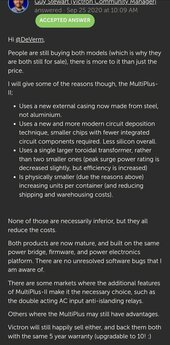It is my understanding that if you are not feeding beck to the grid there is no real operational difference between the Victron Multiplus and Multiplus-II.
There is a pretty slight difference in the draw to run the inverters with the Multiplus II being a little more efficient (similar to the draw of an LED bulb), but not enough to change the maximum efficiency rating. Both the 24V Multiplus and MUltiplus-II have a maximum efficiency of 94%. The great blue one,
@sunshine_eggo , should be here soon to make sure all that I am telling you is accurate.
So the real difference between the two is the form factor:
The
Multiplus is shorter but sticks out further (14.3"h x 10.2"w x 8.6"d)
Where the
Multiplus II is taller but flatter (21.1"h x 10.9"w x 5.8"d)
In a home based system this might not matter to much, but in my RV it is huge and the deciding factor. (
I needed the shorter height of the Multiplus fro my RV.)
The part number for the 24V UL version of the Victron Multiplus is
PMP242200102.
It also looks like, in general, the Multiplus is about $100 less than the Multiplus II.



